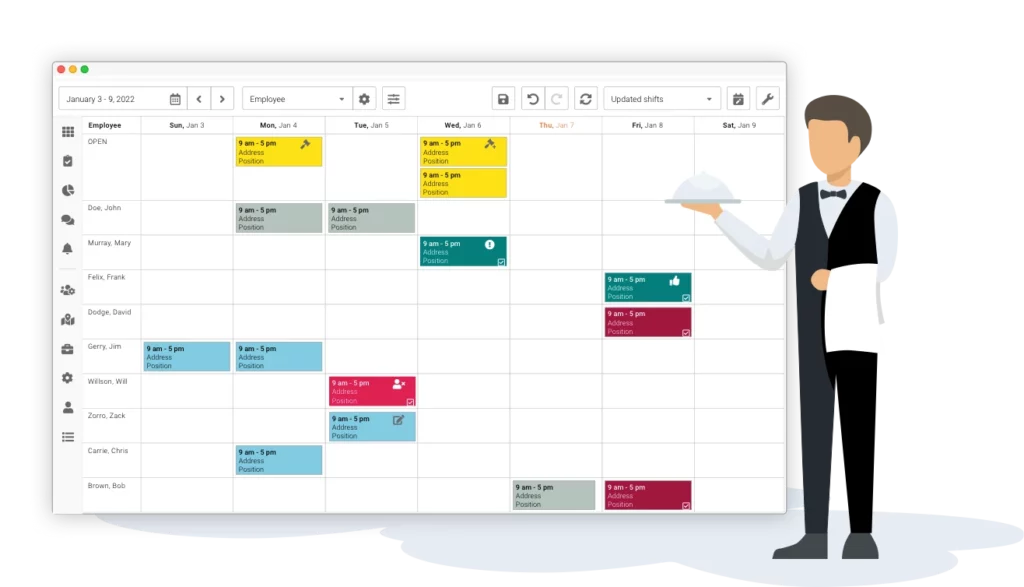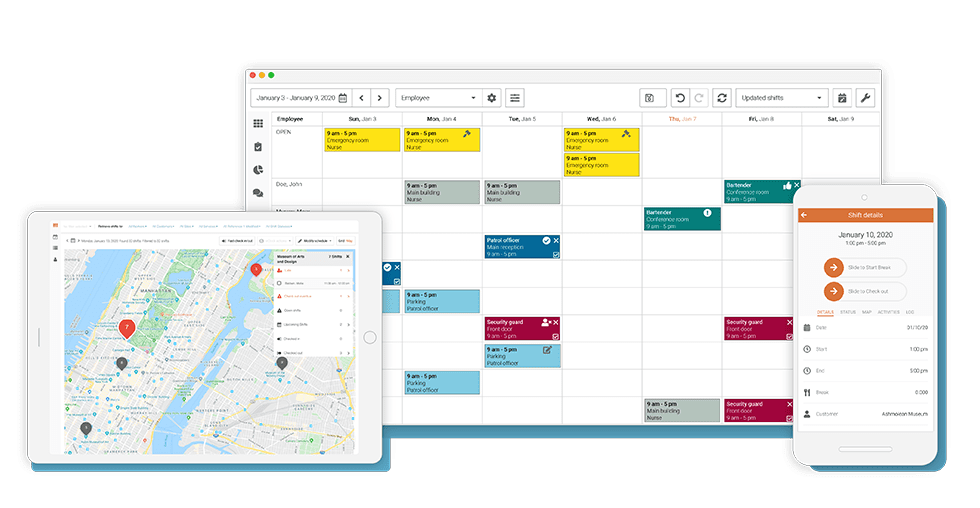Have you ever encountered scheduling conflicts as an employer? Probably. Has there ever been an instance that your schedule panned out perfectly? Rarely. More often than not, scheduling conflicts do arise. For example, up to 6% of full-time laborers are unexpectedly absent regularly, as per the U.S. Bureau of Labor Statistics report.

To make matters worse, these conflicts often arise at the last minute. There’s no doubt that employee scheduling is a tedious and challenging task, especially when required to schedule hundreds of employees. Such conflicts reveal that even years of experience may not be enough to get the perfect schedule.
So, how can we avoid them? First and foremost, handling such conflicts requires an effective plan involving research, communication, and a bit of patience. Before getting into the details, let’s look into some scheduling conflicts that frequently surface in the workplace.
Common Scheduling Conflicts
DOUBLE-BOOKING
Double-booking is a type of scheduling conflict where employees are scheduled for two shifts simultaneously. These shifts could be at the same or a different location, with the latter scenario having a more negative effect.
Imagine a situation where an employee is required for two different stores and the two store managers have no information regarding the double-booking. The result of such scheduling errors is understaffing and overworked employees. Imagine the added burden for workers required to make up for such unexpected yet inevitable missed shifts.
OVERLAPPING EVENTS

Overlapping events occur when two events are scheduled in such a way that their timings overlap. They are more disguised than double-booking and can have severe repercussions if not handled properly.
While overlapping events are more industry-specific, in general, they often lead to either postponing one event or requiring employees to run back and forth between both events. A typical example would be an employee having a meeting with a client scheduled at the same time as a mandated office-wide quarterly meeting. Such a scenario is unlikely yet has potential for trouble. It might also be as simple as having a wedding, and another large function that requires a lot of employees, but failing to schedule enough employees.
BOOKING AN UNAVAILABLE TIME SLOT
Employees, whether part-time or full-time, are allowed to have scheduled time off as per legal requirements. Also, part-time workers have time slots where they are unavailable to pick up a shift. If a scheduler schedules a shift for an employee without confirming their availability, it can hinder the schedule altogether. If an employee is scheduled for a time they can’t work, they may end up calling in sick – leaving the scheduler scrambling to find cover.
Finalizing a schedule before confirming shifts is a rookie mistake in scheduling. Nevertheless, professionals with years of scheduling experience can make such a mistake when managing a big pool of employees.
UNBALANCED SHIFT DISTRIBUTION
Scheduling some employees more than others results in an unbalanced shift distribution. Sometimes, it might be understandable such as one employee being more available or more hardworking or passionate than other employees. However, at other times this can create conflict between team members. They’re most likely to occur not because of the number of shifts given but because of the types of shifts offered.

For example, two similar employees might be assigned two different shifts where one shift is preferable over the other. If a particular employee always gets the preferable shift, the other employees are likely to raise a complaint. The definition of a preferable shift might be vague, but it’s possible that unpreferable shifts can lead to a cycle of decreasing productivity and fewer shifts offered.
The four points above describe how scheduling conflicts can occur due to human error (miscommunication) or bias. Effectively handling such disputes can be difficult when put under immense pressure. Let’s take a look at some methods of handling scheduling conflicts that managers can take advantage of.
Tips for Handling Scheduling Conflicts
BE MORE UNDERSTANDING:
Adopting an understanding approach is essential when staff members miss a shift. Taking this approach can often impact an employee not missing a shift repeatedly and developing a pattern. The leading cause of employees missing a shift is distress, and further distressing the employee for missing a shift is not the right approach.
A relatively gentle or personal conversation can be more helpful to employees seeking guidance during times of distress. Moreover, there’s always a possibility that employees are not always the reason behind the no-show. Instead, there might be a scheduling error or confusion that might have occurred. Striving to understand what went wrong is more important here than passing the blame.
EMPLOYEE BACKUPS:
One of the significant benefits of having a large pool of employees is the option of having last-minute backups. While not entirely the most preferred choice, calling a backup can be extremely helpful for any organization if productivity or profitability is at stake.
If there is no staff available to take a shift, assigning backups to each employee can significantly reduce the time to find a replacement for your unavailable employee. This is probably the most effective solution to a scheduling conflict where a scheduler has booked an employee for an unavailable time slot.
GIVE WORKERS THE ABILITY TO PROPOSE AN ALTERNATE TIME:

First and foremost, it’s more likely that employees will be present for a shift they choose. Given that they’ll select shifts they’re available for, it’s unlikely that an employer will book an employee for an unavailable time slot. Nevertheless, it’s still possible that employees miss their shifts or employers ignore or forget an employee’s availability.
In such situations, it’s beneficial for the employer to give employees the ability to decide who gets the shift. To ensure that all shifts are covered, employees themselves can help each other through shift swapping. Employers can then save a lot of time and energy. Their job would be to approve any changes that the employees make.
This way, employees also get more autonomy over their availability, time off requests, or other scheduling changes.
OFFER EMPLOYEES BENEFITS FOR HELPING OR COVERING A SHIFT:
In addition to the previous point, employees may not accept last-minute shifts without being rewarded for their flexibility. The benefits might not have to be monetary but can be other perks such as a more extended break or free lunch.
Of course, the requirement is that the perks have to be enticing enough for the employees. For instance, employers could keep a tally of the amount of compromises employees have made to be then used to decide on promotions or bonuses. This can overall increase employee engagement whilst also not costing the company additional money.
USE A CENTRALIZED EMPLOYEE SCHEDULE:
The role of a centralized employee schedule is to cut down on scheduling conflicts that arise from multiple managers developing a manual schedule. Centralization is key here because such a system can improve information communication, whether it be employee availability or any manager’s requirement. An employee scheduling software is such a solution.

Employee scheduling software consists of a rules engine that can prevent scheduling conflicts from taking place while creating a schedule. This rules engine allows schedulers to list a series of conditions and qualifications for any shift that must be followed. With a centralized system, conditions and requirements such as the availability of an employee or the maximum hours they can work are stored as information that can then be used while making the schedule.
The software can store this information for all the employees and then make a schedule based on the requirements of employers and employees. Through automation, any issues such as double-booking or overlapping events would not occur as the software removes any possibility of human error.
Moreover, features such as ‘Find Replacement’ or ‘Shift Bidding’ are available for employers and employees to use if any employee unexpectedly misses their shift. It’s also a great way to find cover for unavailable team members. Lastly, employers can always set new rules and communicate with employees instantly regarding any scheduling issues. Last-minute changes to a schedule can be sent out to employees via the scheduling app. This lowers the chances of no-shows. As a result, employees have a platform to communicate any issue regarding fairness in scheduling and notify the employer if they are unable to make it for a shift.
The End of Scheduling Conflicts?
It’s unlikely that scheduling conflicts will be reduced to zero even if the methods mentioned above are employed. However, with constant advancements and improvements in Celayix’s employee scheduling software, it’s only a matter of time. With tools like this, avoiding scheduling conflicts has become so much easier.
As more features are developed and communication between employers and employees improves, our scheduling software will surely be one of the most effective ways for any organization to handle scheduling conflicts. If you’d like to hear more about how Celayix can help you reduce scheduling conflicts, be sure to contact a solutions advisor today!





